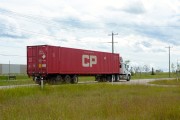When Canada's federal government published an update to its regulatory approach for heavy industry this month, environmentalists combed the documents in the hopes that this much-criticized proposal had been strengthened.
Instead, the update offered a mixed bag that, on balance, probably served to weaken an already feeble approach - and the new rules will likely have the effect of taking some big players out of the emissions trading market.
A bit of background: the federal government first published a regulatory framework it called Turning the Corner in April 2007. Although it included other regulations, greenhouse gas targets for Canada's heavy industry sectors were at the heart of the framework. The proposal came under heavy fire for its use of intensity-based targets, its generous compliance options, and its permissive treatment of the tar sands sector - the largest single contributor to projected growth in Canada's GHG emissions.
This month's update represented a significant opportunity to close some of the loopholes. The government responded with a new approach for the tar sands and coal-fired power sectors based on carbon capture and storage (CCS). Some Canadian media outlets hailed this as a groundbreaking "requirement" for CCS.
Capturing and storing carbon should be mandatory for any new facility in Canada's tar sands. Unfortunately, the fine print revealed that there is no such requirement - just targets set at CCS levels for new tar sands in situ facilities, upgraders and coal-fired power plants that start up after 2011. These targets comes into effect only in 2018, a full decade away. The proposal also leaves key questions (including the scope of these targets and the compliance options to meet them) unanswered pending the publication of draft regulations, which have now been delayed to the fall.
The 2012 cut-off means that many facilities currently under construction or at the late planning stages will get in "under the wire." (Instead of CCS-level targets, these facilities get a three-year "grace period," followed by targets based on use of the industry-standard fuel, natural gas, and an annual 2% emission intensity improvement.) In fact, the government's leisurely approach to implementing CCS-level targets will, perversely, encourage even faster construction in this already overheated area.
The decision to "backload" the bulk of emission reductions to 2018 and later is highly questionable for a government that says it's on track to meet a national GHG target in 2020 - albeit one that falls far short of what the science calls for from a developed country.
The government's announcement also opened up a significant new loophole through a compliance option it calls "pre-certified investment credits."
These credits allow emitters to apply for government approval of future emission reduction projects undertaken in their own operations or as joint ventures. Once a project is certified, emitters can meet part of their regulatory obligation by making contributions towards it, starting at a rate of $15/tonne CO2e in 2010 and ramping up to just under $25/tonne by the time this mechanism is phased out in 2018.
By promising to implement CCS in 2018, a company becomes eligible to meet 100% of its obligation until then simply by setting dollars aside for the capital spending. Clearly, the government is hoping that all new oilsands facilities starting up after 2012 will make use of this offer.
Although the focus is on tar sands, other "large-scale and transformative" project proponents could also apply. For example, the province of Ontario's coal-fired power plants could meet their regulatory obligation mainly by earmarking funds for future investments in nuclear power.
By creating a new form of "in-house" compliance, this loophole will likely move some major companies out of Canada's nascent carbon market altogether, at least until the CCS-level targets are applied in 2018.
It looks like Canada's industrial emissions won't be turning that corner anytime soon.






